48 F. average St. Cloud high temperatures on April 1.
37 F. high on April 1, 2016.
April 2, 2001: Jumbo-sized snowflakes fall in east central Minnesota and west central Wisconsin. 2.5 to 2.75 inch flakes measured in Maplewood.
April 2, 1920: The temperature falls to 8 degrees in Pipestone. The high the day before was 74.

The Perils of Tornado Amnesia - Time to Prepare
"One of the keys to happiness is a bad memory" said Rita Mae Brown. What keeps me up at night? The possibility of an EF-4 or EF-5 tornado steam-rolling through the close-in Twin Cities suburbs.
Cheap, headline-churning hype? It happened in 1965, from Chanhassen to Fridley as a series of EF-4 strength tornadoes churned across the western and northern suburbs.
We've had 6 fairly quiet tornado seasons in Minnesota since 2010, when 113 tornadoes touched down, most in the USA. That's the year Wadena was hit by an EF-4.
Officials worry about amnesia after a string of quiet years. Many people forget that we can see large, violent twisters.
Nationwide a typical year brings 1,200 tornadoes, 80 fatalities and a billion dollars in damage. With rising temperature and humidity comes an elevated risk of severe storms, peaking in May and June.
Garden-variety showers sprout later today; maybe steadier rain Wednesday as another Pacific storm churns to our south. 50s are the rule this week; low 60s next weekend as a springy warm front flirts with Minnesota.
March was the 19th month in a row warmer than average in the Twin Cities. The last cool month at MSP? August 2015.
Moderate and major tornado tracks since 1950: NOAA SPC.
March: 19th Month in a Row of Warmer Than Average at MSP. Here's an excerpt from Dr. Mark Seeley at Minnesota WeatherTalk: "Most climate observers reported mean monthly temperature values near normal, or 1 to 2 degrees F warmer than normal for the month. For MSP Airport it was the 19 consecutive month with above normal temperature. For most climate stations over half the days of the month were warmer than normal. Minnesota reported the coldest temperature in the nation on four dates during the month:
-20°F at Embarrass on the 3rd
3°F at Warroad and Flag Island on the 8th
-4°F at Embarrass on the 9th
-11°F at Crane Lake on the 14th
Extreme values of temperature for the month ranged from 74°F at Redwood Falls on the 6th to -21°F at Cotton (St Louis County) on the 4th..."
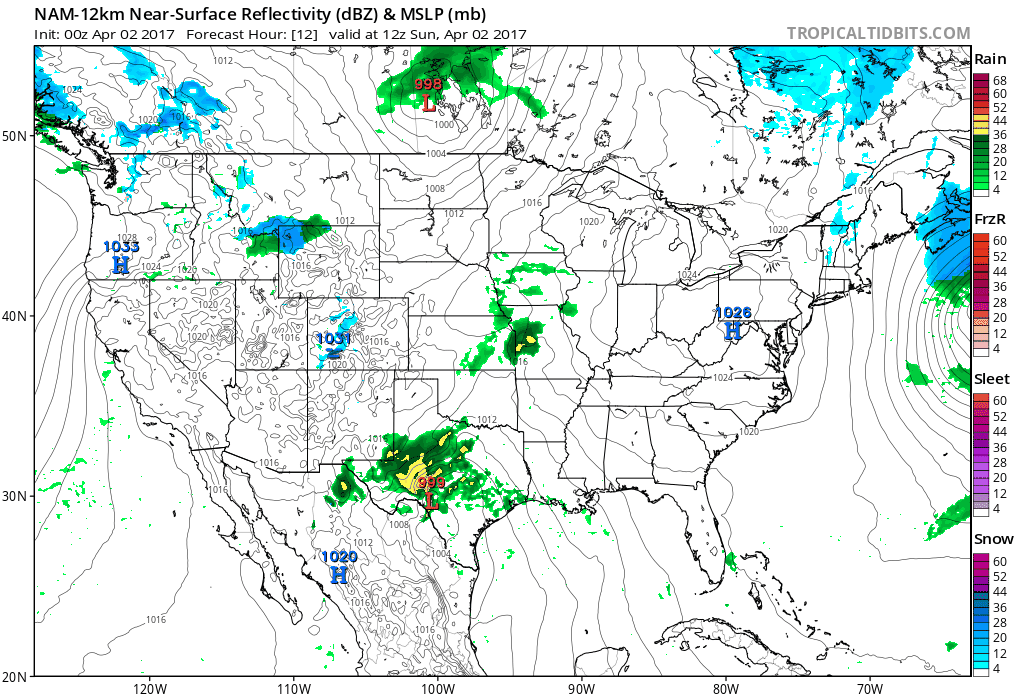
Parade of Sloppy Storms. Today's storm spawns a squall line of tornadic thunderstorms from eastern Texas into Louisiana, then pushes a shield of moderate rain across the Midwest and Great Lakes into England, where precipitation will mix with ice and snow over northern New Hampshire and Maine. California enjoys a quiet/dry spell, but more heavy rain pushes into the Pacific Northwest by Wednesday. 84-hour NAM: NOAA and Tropicaltidbits.com.
Towns Where April Is Snowiest Month of the Year.
Who knew? From the Black Hills of South Dakota into parts of Colorado
and Wyoming, according to research compiled by prolific climate guru
Brian Brettschneider.
7-Day Rainfall.
NOAA's model ensembles predict heaviest rainfall amounts for the
southern USA and from northern California north to Vancouver. A couple
inches of rain may douse much of the Midwest and New England by next
weekend.
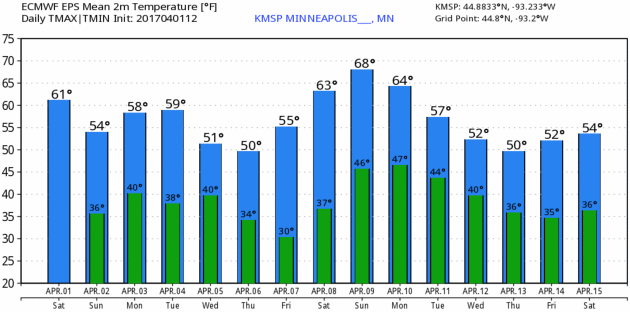 Spring Hangs On.
We'll see another minor temperature relapse late next week before the
mercury surges close to 70F one week from today. After a few false
starts the maps are looking more springlike. Twin Cities temperatures:
WeatherBell.
Spring Hangs On.
We'll see another minor temperature relapse late next week before the
mercury surges close to 70F one week from today. After a few false
starts the maps are looking more springlike. Twin Cities temperatures:
WeatherBell.
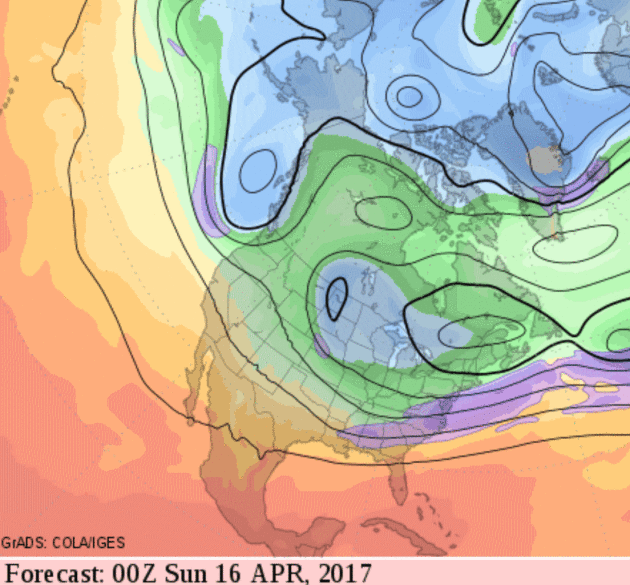 A Few More Atmospheric Potholes.
The road to spring is never a smooth one. There are setbacks,
roadblocks, potholes capable of temporarily detouring and delaying warm
weather gratification. The sun is too high in the sky for a
February-like relapse, but 2 weeks out GFS model ensembles show a
cut-off low over the Upper Midwest capable of cool, showery unsettled
weather.
A Few More Atmospheric Potholes.
The road to spring is never a smooth one. There are setbacks,
roadblocks, potholes capable of temporarily detouring and delaying warm
weather gratification. The sun is too high in the sky for a
February-like relapse, but 2 weeks out GFS model ensembles show a
cut-off low over the Upper Midwest capable of cool, showery unsettled
weather.
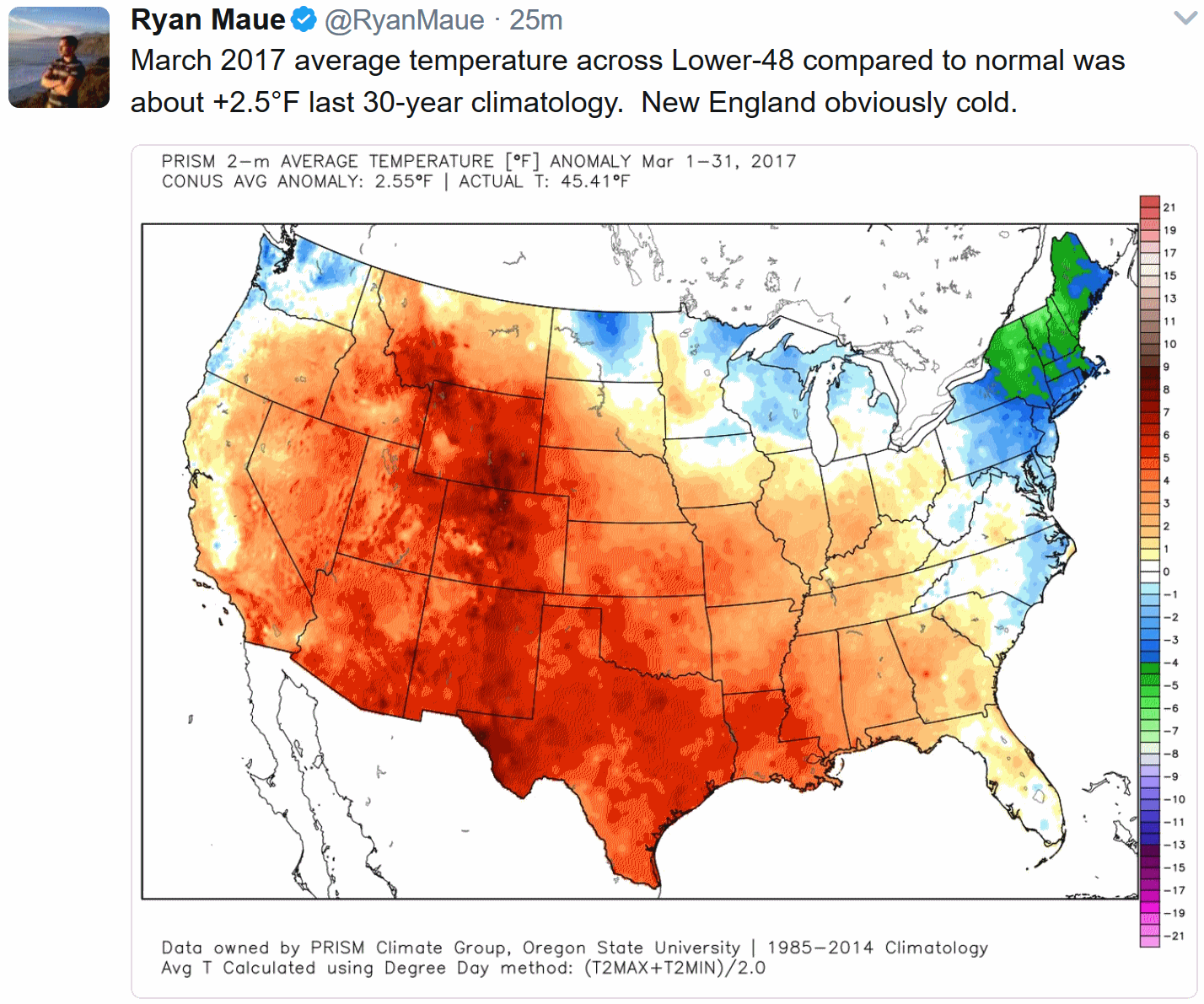

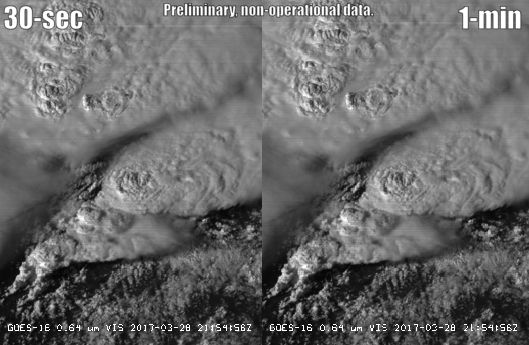
Minnesota Should Not Be Affected by Trump's Rescinding Clean Power Plan. Star Tribune reports: "President Donald Trump’s efforts to roll back clean power standards will probably have a minimal effect on Minnesota, since state policy — combined with changing energy economics — has already been leading utilities away from coal. As expected, Trump on Tuesday signed an executive order aimed at rescinding former President Barack Obama’s climate-change initiatives, including the Clean Power Plan. But many utilities in Minnesota are already on a clean-power path. “They are going to make the [carbon] reduction that would be required under the Clean Power Plan anyway,” said Will Seuffert, executive director of the Minnesota Environmental Quality Board, which coordinates environmental policy across state agencies..."
Photo credit: "Xcel Energy has switched on 160 megawatts of solar power in the past few months, including a massive project in Chisago County." Source: Aaron Lavinsky, Star Tribune.
Wind Power Cuts CO2. Here's an excerpt from Climate Central: "We’ve reached the end of the windiest month of the year. But in other months, wind will continue to play an increasingly large role in the U.S. power mix. At the end of last year, wind capacity surpassed hydroelectric capacity for the first time in the U.S. Over the past decade, wind power has exploded in the U.S. Over that time, generating capacity from wind has increased by a factor of seven, surpassing 82,000 megawatts, or enough to power 24 million homes. Wind is most consistent in the Great Plains and on the Front Range of the Rockies. The prevailing west winds come rushing off of the mountains, making the area especially conducive for generating electricity, as higher wind speeds produce disproportionately more power from a wind turbine..."
Clean Energy Employs More People Than Fossil Fuels in Nearly Every U.S. State. Here's a clip from ThinkProgress: "Nationally, clean energy jobs outnumber fossil fuel jobs by more than 2.5 to 1, according to a new Sierra Club analysis of Department of Energy jobs data. And when it comes to coal and gas — two sectors President Donald Trump has promised to bolster through his upcoming executive order on energy regulation — clean energy jobs outnumber jobs dealing with those two fossil fuels by 5 to 1. “Right now, clean energy jobs already overwhelm dirty fuels in nearly every state across America, and that growth is only going to continue as clean energy keeps getting more affordable and accessible by the day,” Sierra Club executive director Michael Brune said in a statement..."
Photo credit: AP Photo/Ross D. Franklin.
UW Professor: The Information War is Real, and We're Losing It. Because conspiracy theories are so much more interesting than reality. Here's an excerpt of a harrowing story at The Seattle Times: "...Starbird is in the UW’s Department of Human Centered Design & Engineering — the study of the ways people and technology interact. Her team analyzed 58 million tweets sent after mass shootings during a 10-month period. They searched for terms such as “false flag” and “crisis actor,” web slang meaning a shooting is not what the government or the traditional media is reporting it to be. It happens after every mass shooting or attack. If you search for “false flag” and “Westminster,” you’ll find thousands of results theorizing that last week’s attack outside British Parliament was staged (presumably to bring down Brexit, which makes no sense, but making sense is not a prerequisite). Starbird’s insight was to map the digital connections between all this buzzing on Twitter with a conglomeration of websites. Then she analyzed the content of each site to try to answer the question: Just what is this alternative media ecosystem saying?..."
Photo credit: "PROPHET MOTIVE: Elon Musk, co-founder of Tesla and OpenAI, inside part of a SpaceX Falcon 9 rocket, in Cape Canaveral, Florida, 2010." Photograph by Jonas Fredwall Karlsson.

A Quick Guide to Backing Up Your Critical Data. You can't back up your files enough, I've learned the hard way, especially family photos and videos. here's an excerpt from The New York Times: "...An automated backup system can preserve all the essential files, even your iTunes library, that are stored on your computer. Microsoft includes File Recovery software with Windows 10 (or Backup and Restore if the computer is running Windows 7), while Apple’s Mac operating system has had the Time Machine program for backup since 2007. For those who want more than the basic built-in backup software, third-party programs like Acronis True Image (for Windows and Mac, as well as Android and iOS) or Carbon Copy Cloner (for Mac) can grab a backup of the entire computer..."
Why You Should Be Walking 7 Miles a Day - At Least. Does driving 7 miles a day count? Here's a snippet from Esquire: "...But walking any
amount lessened the risk, putting the mail carriers at an advantage.
Mail carriers who walked more than three hours a day had no heightened
risk for heart disease at all—their BMIs, metabolisms, cholesterol
levels, and blood sugar levels were normal. So, according to this
(small, limited) study, 15,000 steps keeps people healthy. For those
curious, 15,000 steps is equivalent to about seven miles of walking.
Easy. People can get 15,000 steps a day "by walking briskly for two
hours at about a four-mile-per-hour pace," lead researcher Dr. William
Tigbe told The Times. (An
average walking pace is three miles per hour.) Another totally
realistic suggestion was "a 30-minute walk before work, another at
lunch, and multiple 10-minute bouts throughout the day..."
An Updated (and Depressing) List of All the April Fool's Pranks on the Internet. Some of these are excellent, I must say. Here's an excerpt of an amazing rundown at The Washington Post:
- Eau de Chlôrine, a perfume that makes you smell like a swimming pool, isn’t real.
- Plated isn’t launching a perfume line that makes you smell like food.
- Coffee-mate didn’t make a coffee-flavored creamer.
- Auntie Annie’s isn’t launching a rebrand that puts a Snapchat filter on their logo.
- You can’t buy these invisible glasses.
- This isn’t a real ad for adult diapers.
- Women can’t rent a fully-furnished storage unit as a “She Shed” to escape their families.
- Progressive isn’t selling insurance for people who are moving to Mars.
- Whopper toothpaste :(
- You can’t ship yourself to a friend in a “man freight”
- Jim Beam isn’t going to start selling canned beans
- “Chugg” isn’t a real energy drink for college kids
- Kars4Kids isn’t really a service that gives cars to children so they can drive them...
TODAY: More clouds, late showers pop up. Winds: S 8-13. High: 54
SUNDAY NIGHT: Few evening showers. Low: 44
MONDAY: Intervals of sun. Stray shower for Twins Opener. Winds: NE 5-10. High: 58
TUESDAY: More clouds than sun, probably dry. Winds: E 5-10. Wake-up: 48. high: 56
WEDNESDAY: Raw, steadier rain possible. Winds: NE 10-20+ Wake-up: 41. High: 49
THURSDAY: Mostly cloudy, drying out. Winds: N 10-15. Wake-up: 38. High: 51
FRIDAY: Sunny and pleasant again. Winds: SE 3-8. Wake-up: 34. High: 55
SATURDAY: Sunny, breezy and milder. Feverish. Winds: S 10-20. Wake-up: 37. High: 62
MONDAY: Intervals of sun. Stray shower for Twins Opener. Winds: NE 5-10. High: 58
TUESDAY: More clouds than sun, probably dry. Winds: E 5-10. Wake-up: 48. high: 56
WEDNESDAY: Raw, steadier rain possible. Winds: NE 10-20+ Wake-up: 41. High: 49
THURSDAY: Mostly cloudy, drying out. Winds: N 10-15. Wake-up: 38. High: 51
FRIDAY: Sunny and pleasant again. Winds: SE 3-8. Wake-up: 34. High: 55
SATURDAY: Sunny, breezy and milder. Feverish. Winds: S 10-20. Wake-up: 37. High: 62
Climate Stories...
Twitter Feed. Characteristics of chronic climate science deniers? NASA's Gavin Schmidt reviewed a few symptoms in a recent Twitter exchange.
Climate Executive Order Leaves Communities More Vulnerable to Disasters. Here's an excerpt from Vox: "...Trump’s move to pull back the federal government’s consideration of climate change in planning may prove to be a shot in the foot. “Given the president’s focus on building infrastructure and his desire to cut federal spending, many analysts said it would make sense for him to maintain or even expand programs to reduce the cost of disasters,” Bloomberg’s Christopher Flavelle writes. Why spend money on developments that may get washed away in a future flood? Extreme weather events are expected to become more frequent and unpredictable in the future, and increase in severity. And the cost of climate-related disasters — like hurricanes, floods, and tornadoes — is higher than ever. What’s more, as the country grows wealthier, disasters are going become even costlier..." (Image credit: NOAA).
Does the New Environmental Executive Order Threaten National Security? TheHill has additional perspective: "In March 2013, four-star Admiral Samuel Locklear III sat down with a Boston Globe reporter
in a Cambridge hotel. As head of the Pacific Command, Admiral Locklear
commanded the 400,000 troops stationed in the Pacific Command,
stretching from California to India to Korea. The admiral had to worry
about North Korea’s nuclear capabilities, tensions between China and
Japan over the South and East China Seas and typhoons in the Pacific.
But when reporter Bryan Bender asked him what was the biggest long-term
security threat in the Pacific region Admiral Locklear gave a two-word
answer: “climate change.” He explained, “If it goes bad, you could have
hundreds of thousands or millions of people displaced and then security
will start to crumble pretty quickly...”
No comments:
Post a Comment